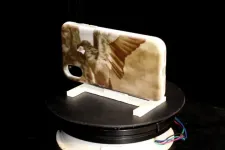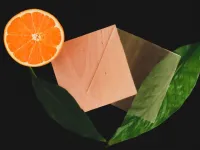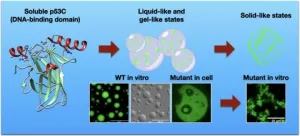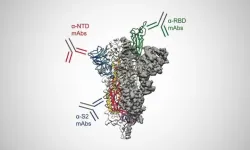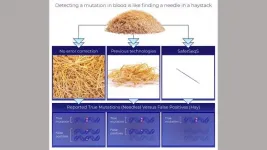(Press-News.org) When was the last time you repainted your car? Redesigned your coffee mug collection? Gave your shoes a colorful facelift?
You likely answered: never, never, and never. You might consider these arduous tasks not worth the effort. But a new color-shifting "programmable matter" system could change that with a zap of light.
MIT researchers have developed a way to rapidly update imagery on object surfaces. The system, dubbed "ChromoUpdate" pairs an ultraviolet (UV) light projector with items coated in light-activated dye. The projected light alters the reflective properties of the dye, creating colorful new images in just a few minutes. The advance could accelerate product development, enabling product designers to churn through prototypes without getting bogged down with painting or printing.
ChromoUpdate "takes advantage of fast programming cycles -- things that wouldn't have been possible before," says Michael Wessley, the study's lead author and a postdoc in MIT's Computer Science and Artificial Intelligence Laboratory.
The research will be presented at the ACM Conference on Human Factors in Computing Systems this month. Wessely's co-authors include his advisor, Professor Stefanie Mueller, as well as postdoc Yuhua Jin, recent graduate Cattalyya Nuengsigkapian '19, MNG '20, visiting master's student Aleksei Kashapov, postdoc Isabel Qamar, and Professor Dzmitry Tsetserukou of the Skolkovo Institute of Science and Technology.
ChromoUpdate builds on the researchers' previous programmable matter system, called PhotoChromeleon. That method was "the first to show that we can have high-resolution, multicolor textures that we can just reprogram over and over again," says Wessely. PhotoChromeleon used a lacquer-like ink comprising cyan, magenta, and yellow dyes. The user covered an object with a layer of the ink, which could then be reprogrammed using light. First, UV light from an LED was shone on the ink, fully saturating the dyes. Next, the dyes were selectively desaturated with a visible light projector, bringing each pixel to its desired color and leaving behind the final image. PhotoChromeleon was innovative, but it was sluggish. It took about 20 minutes to update an image. "We can accelerate the process," says Wessely.
They achieved that with ChromoUpdate, by fine-tuning the UV saturation process. Rather than using an LED, which uniformly blasts the entire surface, ChromoUpdate uses a UV projector that can vary light levels across the surface. So, the operator has pixel-level control over saturation levels. "We can saturate the material locally in the exact pattern we want," says Wessely. That saves time -- someone designing a car's exterior might simply want to add racing stripes to an otherwise completed design. ChromoUpdate lets them do just that, without erasing and reprojecting the entire exterior.
This selective saturation procedure allows designers to create a black-and-white preview of a design in seconds, or a full-color prototype in minutes. That means they could try out dozens of designs in a single work session, a previously unattainable feat. "You can actually have a physical prototype to see if your design really works," says Wessely. "You can see how it looks when sunlight shines on it or when shadows are cast. It's not enough just to do this on a computer."
That speed also means ChromoUpdate could be used for providing real-time notifications without relying on screens. "One example is your coffee mug," says Wessely. "You put your mug in our projector system and program it to show your daily schedule. And it updates itself directly when a new meeting comes in for that day, or it shows you the weather forecast."
Wessely hopes to keep improving the technology. At present, the light-activated ink is specialized for smooth, rigid surfaces like mugs, phone cases, or cars. But the researchers are working toward flexible, programmable textiles. "We're looking at methods to dye fabrics and potentially use light-emitting fibers," says Wessely. "So, we could have clothing -- t-shirts and shoes and all that stuff -- that can reprogram itself."
The researchers have partnered with a group of textile makers in Paris to see how ChomoUpdate can be incorporated into the design process.
INFORMATION:
This research was funded, in part, by Ford.
Written by Daniel Ackerman, MIT News Office
Additional background
Paper: "ChromoUpdate: Locally Updating Photochromatic Multi-Color Textures for Fast Design Iterations"
https://hcie.csail.mit.edu/research/chromoupdate/ChromoUpdate_pressrelease.pdf
Since it was first introduced in 2016, transparent wood has been developed by researchers at KTH Royal Institute of Technology as an innovative structural material for building construction. It lets natural light through and can even store thermal energy.
The key to making wood into a transparent composite material is to strip out its lignin, the major light-absorbing component in wood. But the empty pores left behind by the absence of lignin need to be filled with something that restores the wood's strength and allows light to permeate.
In earlier versions of the composite, researchers at KTH's Wallenberg Wood Science Centre used fossil-based polymers. Now, the researchers have successfully tested an eco-friendly alternative: limonene acrylate, a monomer made ...
Cancer has been recently shown to be affected by protein clusters, particularly by the aggregation of mutant variants of the tumor suppressor protein p53, which are present in more than half of malignant tumors. However, how the aggregates are formed is not yet fully understood. The understanding of this process is expected to provide new therapeutic tools able to prevent proteins to clump and cancer progression.
In Brazil, researchers at the Federal University of Rio de Janeiro have identified a key mechanism behind the mutant p53 aggregation process, linked to cancer pathology, opening new paths for the development of novels ...
BAR HARBOR, MAINE — Our kidneys are charged with the extraordinary task of filtering about 53 gallons of fluid a day, a process that depends on podocytes, tiny, highly specialized cells in the cluster of blood vessels in the kidney where waste is filtered that are highly vulnerable to damage.
In research at the MDI Biological Laboratory in Bar Harbor, Maine, a team led by Iain Drummond, Ph.D., director of the Kathryn W. Davis Center for Regenerative Biology and Aging, has identified the signaling mechanisms underlying podocyte formation, or morphogenesis. The discovery opens the door to ...
A team of University of Alberta researchers has discovered a way to use 3-D bioprinting technology to create custom-shaped cartilage for use in surgical procedures. The work aims to make it easier for surgeons to safely restore the features of skin cancer patients living with nasal cartilage defects after surgery.
The researchers used a specially designed hydrogel--a material similar to Jell-O--that could be mixed with cells harvested from a patient and then printed in a specific shape captured through 3-D imaging. Over a matter of weeks, the material is cultured in a lab to become functional cartilage.
"It takes a lifetime to make cartilage in an individual, while this method takes about four weeks. So you still expect ...
Metallacages prepared via coordination-driven self-assembly have received extensive attention because of their three-dimensional layout and cavity-cored nature. The construction of light-emitting materials employing metallacages as a platform has also gained significant interest due to their good modularity in photophysical properties, which bring emerging applications in fields as diverse as sensing, biomedicine, and catalysis.
However, the luminescence efficiency of conventional luminophores significantly decreases in the aggregate state because they encounter unfavorable aggregation-caused quenching (ACQ). Therefore, it was quite a challenge to fabricate light-emitting metallacages with high luminescence efficiency in various physical states.
In 2001, Tang's group ...
The most complete picture yet is coming into focus of how antibodies produced in people who effectively fight off SARS-CoV-2 work to neutralize the part of the virus responsible for causing infection. In the journal Science, researchers at The University of Texas at Austin describe the finding, which represents good news for designing the next generation of vaccines to protect against variants of the virus or future emerging coronaviruses.
Previous research focused on one group of antibodies that target the most obvious part of the coronavirus's spike protein, called the receptor-binding domain (RBD). Because the RBD is the part of the spike that attaches directly to human cells and enables the virus to infect them, ...
New York, NY (May 4, 2021) - A powerful, long-term study from WCS adds scientific backing for global calls for conserving 30 percent of the world's ocean. The studied no-take marine protected areas (MPAs) increased the growth of fish populations by 42 percent when fishing was unsustainable in surrounding areas, achieving the benefits of stable and high production of fish populations for fishers, while protecting threatened ecosystems.
The study recorded fish catches for 24-years across a dozen fish landing sites within two counties in Kenya, which allowed scientists to evaluate the long-term impacts of two different fisheries management methods. While one county ...
Harsh prison sentences for juvenile crimes do not reduce the probability of conviction for violent crimes as an adult, and actually increase the propensity for conviction of drug-related crimes, finds a new study by economists at UC Riverside and the University of Louisiana. Harsh juvenile sentences do reduce the likelihood of conviction for property crimes as an adult. But the increase in drug-related crimes cancels out any benefit harsh sentences might offer, researchers found.
"Juvenile incarceration is a double-edged sword which deters future property crimes but makes drug convictions more likely in adulthood. Thus, it's hard to make firm policy recommendations ...
Scientists believe a stomach-specific protein plays a major role in the progression of obesity, according to new research in Scientific Reports. The study co-authored by an Indiana University School of Medicine researcher, could help with development of therapeutics that would help individuals struggling with achieving and maintaining weight loss.
Researchers focused on Gastrokine-1 (GKN1) -- a protein produced exclusively and abundantly in the stomach. Previous research has suggested GKN1 is resistant to digestion, allowing it to pass into the intestine and interact with microbes in the gut.
In the Scientific Reports study, researchers show that inhibiting GKN1 produced significant differences in weight and levels of body fat in comparison to when the protein was expressed.
"While ...
Next-generation gene sequencing (NGS) technologies --in which millions of DNA molecules are simultaneously but individually analyzed-- theoretically provides researchers and clinicians the ability to noninvasively identify mutations in the blood stream. Identifying such mutations enables earlier diagnosis of cancer and can inform treatment decisions. Johns Hopkins Kimmel Cancer Center researchers developed a new technology to overcome the inefficiencies and high error rates common among next-generation sequencing techniques that have previously limited their clinical application.
To correct for these sequencing errors, the research team from the Ludwig Center and Lustgarten Laboratory at the Johns Hopkins ...
